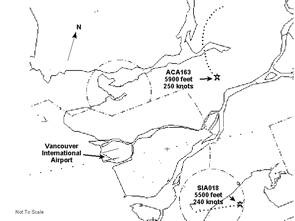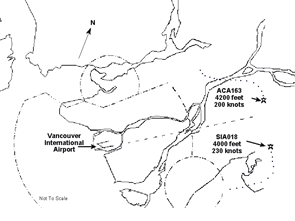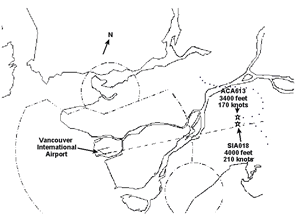Loss of separation
Nav Canada Area Control Centre
Vancouver Terminal - Arrival Low
Vancouver International Airport,
British Columbia
The Transportation Safety Board of Canada (TSB) investigated this occurrence for the purpose of advancing transportation safety. It is not the function of the Board to assign fault or determine civil or criminal liability. This report is not created for use in the context of legal, disciplinary or other proceedings. See Ownership and use of content. Masculine pronouns and position titles may be used to signify all genders to comply with the Canadian Transportation Accident Investigation and Safety Board Act (S.C. 1989, c. 3).
Summary
Air Canada Flight 163 (ACA163), a Boeing 767-200, was inbound to Vancouver from the northeast and vectored to Runway 26R. At the same time, Singapore Airlines Flight 018 (SIA018), an Airbus A340-300, was inbound from the southwest and vectored to Runway 26R. When ACA163 was on right base and descending from about 4800 feet to 3000 feet, SIA018 was established on left base and level at 4000 feet. During this turn onto final, a loss of separation occurred and both aircraft closed to within 600 feet and 1½ nautical miles of each other before the required separation was restored.
Factual information
ACA163 first contacted Vancouver's arrival low controller at 1102:48 Pacific daylight timeFootnote 1 and reported out of 6000 feet, descending to 5000 feet. At that time, the aircraft was turning left to a heading of 080° and descending at about 1000 feet per minute (fpm) while maintaining a speed of about 250 knots. The arrival low controller cleared ACA163 to maintain 3000 feet and cautioned the crew about turbulence because they would be following a heavy aircraft.
SIA018 checked in with the arrival low controller about 20 seconds later, when their aircraft was in a descent and approaching 5000 feet. The controller acknowledged the check-in and cleared the aircraft to continue its descent to maintain 4000 feet on a heading of 070°. The relative positions of the two aircraft after this initial contact with the arrival low controller are shown in Figure 1.
At 1103:31, the controller directed ACA163 to turn right to a heading of 170°. Nine seconds later, the controller directed SIA018 to complete a left turn to a heading of 350°. Once established on this reciprocal track, the combined closing speed of the two aircraft was about 480 knots (8 nautical miles [nm] per minute).
At 1104:06, the arrival low controller vectored ACA163 right to a heading of 230° and cleared the aircraft for an instrument landing system (ILS) approach to Runway 26R with a speed restriction to maintain 170 knots. When ACA163 received the approach clearance and associated speed restriction, the aircraft was descending through about 4800 feet and maintaining a speed of about 250 knots. ACA163 commenced a right turn and began to reduce speed to meet the restriction; during that manoeuvre, the aircraft's rate of descent dropped to about 450 fpm.
The two aircraft closed to about 3.3 nm and were still converging at a rate of about 8 nm per minute when the controller directed SIA018 to turn to a heading of 290° at 4000 feet. (See Figure 2.) He then directed ACA163 to expedite its descent down to 3000 feet for traffic. On receipt of the direction to "expedite" descent, ACA163's rate of descent increased to about 1000 fpm, the turn radius tightened, and the speed remained at 170 knots.
A loss of separation occurred when the two aircraft closed to within 1½ nm and 600 feet in an area where 3 nm horizontal or 1000 feet vertical separation was required. Separation was re-established when ACA163 reached the cleared altitude of 3000 feet.
SIA018 subsequently reported the airport in sight and was given an amended clearance to conduct a visual approach to Runway 26L. ACA163 completed the ILS approach to Runway 26R.
Each aircraft was fitted with a traffic alert and collision-avoidance system (TCAS). Neither crew reported or responded to a TCAS traffic alert or resolution advisory, and crews of both aircraft had reported the opposing traffic in sight.
Nav Canada's primary role is to ensure safe and efficient movement of aircraft within Canadian airspace and international airspace for which it has accepted responsibility to provide air traffic services.
As part of their functions, Nav Canada's air traffic controllers are required to ensure adequate separation is maintained between aircraft. Specific separation standards vary and are detailed in the Canadian Aviation Regulations. To maintain appropriate separation, controllers must plan, take appropriate steps to execute the plan, and monitor the results of their plan. Any breakdown in planning, execution, or monitoring functions is considered to be an irregularity, which could lead to a loss of separation.
Aircrew and controllers follow standardized procedures; use of such procedures reduce the requirement for detailed explanations and excessive radio communication. When on radar vectors, it is important that aircrew follow the direction of a controller to ensure the success of a controller's plan. In general, however, aircrew will only know the part of a controller's plan that is conveyed to them through the communication system.
Under normal circumstances, when slowing an aircraft, there is a natural consequence that an aircraft's rate of descent will reduce.
Nav Canada recognizes an increased risk in directing altitude changes while vectoring aircraft on reciprocal tracks. This type of control plan is considered by Nav Canada to be very unforgiving; it increases a controller's monitoring requirement, increases the risk of error from distraction, and makes recovery from any potential error more difficult. Examples of previous events where this type of control procedure did not work properly have been disseminated to controllers through Nav Canada's internal communication system (Air Traffic Services Bulletin - Squawk 7700 Number 9501).
Analysis
Based on a review of available radar and radio communication information, it is likely that the controller anticipated that Air Canada (arriving from the north) would be down to his cleared altitude (3,000') before lateral separation was lost.
However, when the controller cleared ACA163 for the ILS approach, he also directed a speed reduction to 170 knots. ACA163 responded by commencing a turn and slowing the aircraft to meet the speed restriction. As ACA163 decelerated to meet the directed speed restriction, the aircraft's vertical velocity reduced as a natural consequence. When the controller recognized ACA163's reduced rate of descent, it was too late to correct the situation before losing separation. In part, the controller's time constraint was caused by the use of a vectoring procedure that placed the two aircraft on reciprocal tracks at nearly identical altitudes.
The controller responded by giving SIA018 a turn to the left; this turn helped to reduce the closure rate between the two aircraft. The controller also directed ACA163 to expedite the descent to 3000 feet for traffic. This transmission provided the first indication to ACA163 that a traffic conflict was imminent and that an increased rate of descent was required. The crew responded by increasing their descent rate, maintaining the speed restriction, and tightening the turn to the localizer on course.
Findings
Findings as to causes and contributing factors
- The controller did not ensure that vertical separation was established before lateral separation was lost.
Other findings
- Directing altitude changes while vectoring two arriving aircraft onto reciprocal tracks increases a controller's monitoring requirement, increases the risk of error from distraction, and makes recovery from any potential error more difficult because of the high closing speeds.
- A directed airspeed change is likely to cause a modification to an aircraft's rate of descent.
This report concludes the Transportation Safety Board's investigation into this occurrence. Consequently, the Board authorized the release of this report on .


